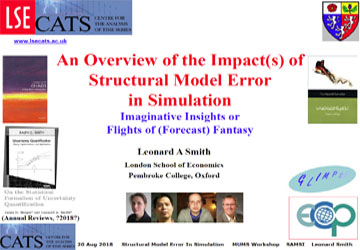Abstract
Modern, large-scale simulation models are often based on the "laws of physics". Interpreting the outputs of these models nevertheless introduces a host of new challenges for uncertainty quantification and decision making. Unlike the traditional low-dimensional models in statistics or in applied maths, the state space of these simulation models is often large (10^7 D) and the components of the model state vector do not correspond to real-world observables. Nevertheless, in contexts like weather and climate, for example, such models sometimes provide significantly more information than traditional empirical models. Structural Model Error (SME) is the difference between the mathematical structure of the simulation model and the system that generates the observations (assuming that the system has a nontrivial mathematical description). In the absence of SME, reducing imprecision in parameter values and in the current state of the system is a daunting but tractable task, and forecasting deterministic systems takes on a probabilistic This presentation illustrates how SME, and the (almost certain) lack of topological conjugacy it implies, has significant impacts on what can be expected from simulation modelling. Challenges to various approaches of Uncertainty Quantification currently used in practice ("ensemble forecasting") and statistical methods exploiting a discrepancy function are demonstrated.
